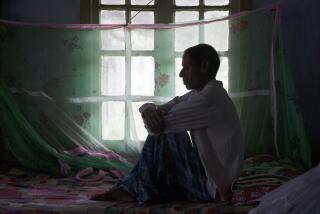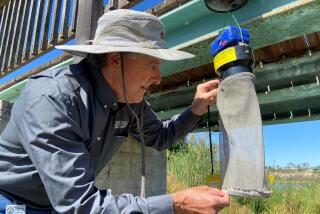New AIDS Cases May Be Down in ’94 : Health: Officials say a change made in 1993 broadening federal guidelines that define the disease may skew figures for this year.
The number of new AIDS cases reported in Ventura County is expected to decline slightly this year after leveling off in 1993, but health officials say those figures may be skewed because of a change in the federal guidelines that define AIDS.
After rising steadily for four years, the number of new cases dropped from 89 in 1992 to 81 in 1993, said Martina Rippey, a county public health nurse who tracks AIDS cases. So far, 52 cases have been reported this year, she said.
In 1993, the federal Centers for Disease Control expanded the definition of AIDS to include patients with low T-cell counts and some individuals who have recurring pneumonia, invasive cervical cancer or pulmonary tuberculosis, Rippey said.
The broader guidelines led county health officials to revise figures on AIDS cases for the past five years and to count many patients with low T-cell counts among the 1993 cases. Under the old guidelines, those individuals would not have been counted until they developed a related illness.
As a result, she said, some patients who would probably not have been included as new AIDS cases until this year were counted last year.
“We will have a glitch in this year’s number,” Rippey said. “My assumption is that in 1995 we’ll start to climb again.
“There’s no doubt that the infection is continuing to spread and the number of AIDS cases is continuing to grow,” she said.
Homosexual and bisexual men still account for the vast majority of the county’s AIDS patients--71%--but the number of AIDS-related illnesses diagnosed among women is growing at a faster rate, Rippey said.
At the county’s immunology clinic, about 16% of the 270 patients infected with the human immunodeficiency virus or who have acquired immune deficiency syndrome are women, up from 10% at the same time last year.
As of July 1, a total of 444 AIDS cases had been diagnosed in Ventura County since 1989. Of those, 285 have died.
Despite the figures showing a two-year plateau in new cases, AIDS workers said the demand for medical services in this county has not slowed.
Dr. John G. Prichard, director of the county’s immunology clinic, said he sees seven to 10 new patients a month, a rate about the same as last year.
Most of the women seeking treatment at the clinic were infected by having sex with intravenous drug users, he said.
Aside from an increase in the number of female patients, Prichard said more Latinos are seeking treatment at the clinic. Latinos now make up about 24% of all clinic patients and about 28% of the AIDS cases diagnosed in Ventura County, Prichard said.
Following a nationwide trend, the average age of new patients in Ventura County has also dropped, particularly for gay men. In 1989, the average patient was in his upper-30s. Today, the typical new patient is in his mid-20s, he said.
“Older gay men are far more aware of this infection and how to prevent it,” Prichard said. “Younger people tend to think of themselves as being immortal.”
For the past 18 months, an outreach program staffed by county workers has sought to reach drug abusers and their sex partners who otherwise might not seek treatment.
The $1-million federally funded HIV Outreach Intervention Team has for the past two years contacted more than 1,000 people every three months, offering free condoms, bleach kits for needles, AIDS testing and counseling.
Of the hundreds of people tested, only three have tested positive for the AIDS virus, said Marsha Flower, the project’s supervisor. She said she was not surprised by the small number.
“I think there’s a marked change in clients taking precautions to protect themselves in whatever area their risks are,” she said. “And there’s a whole group of the population that never test who could be positive.”
More to Read
Sign up for Essential California
The most important California stories and recommendations in your inbox every morning.
You may occasionally receive promotional content from the Los Angeles Times.










